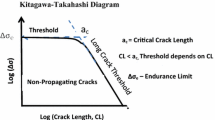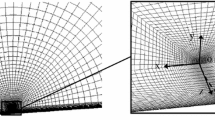Abstract
Fatigue crack-growth is simulated for multiple surface cracks in a plate subjected to different combinations of tension and bending loads. The numerical technique employed is based on the step-by-step integration of a Paris' type of fatigue crack-growth law at a set of points of crack front, which enables the crack shape change during propagation to be traced. The stress intensity factors along the crack front are estimated by the three-dimensional finite element method. The technique has also accommodated an automatic procedure for the regeneration of finite element models as the crack grows, so that the prediction of complex crack shape change undergoing particularly during the crack coalescence is made possible and easy. The fatigue growth behaviours at three typical growth stages, i.e. pre-coalescence, coalescence and post-coalescence, are analysed for two multiple crack configurations. The predicted results are also compared with those obtained by the ASME XI code and a ‘no interaction and immediate transition (NIIT)’ simplified method. It is shown that each individual crack before they touch propagates almost independently and the interaction between them is generally limited despite being dependent on actual crack configurations. The analyses of fatigue lives show that both the ASME XI code and the NIIT method give more conservative results than the present simulation technique; however, the NIIT method is relatively less conservative than the ASME XI code which is excessively conservative for the crack configuration examined.
Similar content being viewed by others
References
Barsoum, R.S. (1976). On the use of isoparametric finite elements in linear fracture mechanics, International Journal of Numerical Methods in Engineering 10, 25–37.
Grandt, Jr., A.F. (1986). An experimental and numerical investigation of the growth and coalescence of multiple fatigue cracks at notches, in ASTM STP 905, 239–252.
Guidance on some methods for the derivation of acceptance levels for defects in fusion welded joints, British Standards Institution, (1980). BSI PD6493, Section 3.
Heath, B.J. and Grandt, A.F. (1984). Stress intensity factors for coalescing and single corner flaws along a hole bore in plate, Engineering Fracture Mechanics 19, 665–673.
Henshell, R.D. and Shaw, K.G. (1975). Crack-tip finite elements are unnecessary, International Journal of Numerical Methods in Engineering 9, 495–507.
Iida, K. (1983). Shapes and coalescence of surface fatigue cracks, in Proceedings of ICF International Symposium on Fracture Mechanics, 22–24, November, Beijing, P.R. China, 679–693.
Kim, Y.J. Yang, W.H., Choy, Y.S. and Lee, J.S. (1992). An interaction analysis of twin surface cracks by the line-spring model, Nuclear Engineering and Design 135, 187–196.
Kishimoto, K., Soboyejo, W.O., Smith R.A. and Knott, J.F. (1989). A numerical investigation of the interaction and coalescence of two coplanar semi-elliptical fatigue cracks, International Journal of Fatigue 11, 91–96.
Lin, X.B. (1994). Numerical Simulation of Fatigue Crack Growth, Ph.D. Thesis, The University of Sheffield, UK.
Lin, X.B. and Smith, R.A. (1995). A numerical simulation of fatigue growth of multiple surface initially semicircular defects under tension, International Journal of Pressure Vessel and Piping 62, 281–289.
Lin, X.B. and Smith, R.A. (1997). An improved numerical technique for simulating the growth of planar fatigue cracks, Fatigue and Fracture of Engineering Materials and Structures (in press).
McComb, T.H., Pope, J.E. and Grandt, Jr., A.F. (1986). Growth and coalescence of multiple fatigue cracks in polycarbonate test specimens, Engineering Fracture Mechanics 24, 601–608.
Morgan, H.G. (1986). Fatigue crack shape development in cracked plates and welded joints, in Proceedings of International Conference on Fatigue and Crack Growth in Offshore Structures, 7–8, April, London, 59–68.
Murakami, Y. and Nemat-Nasser, S. (1982). Interacting dissimilar semi-elliptical surface flaw under tension and bending, Engineering Fracture Mechanics 16, 373–386.
Murakami, Y. and Nemat-Nasser, S. (1983). Growth and stability of interacting surface flaws of arbitrary shape, Engineering Fracture Mechanics 17, 193–210.
Murakami, Y. and Nisitani, H. (1981). Stress intensity factors for interacting two equal semi-elliptical surface cracks in tension, Transactions of Japan Society of Mechanical Engineers Series. A. 47, 295–303.
Newman, Jr., J.C. and Raju, I.S. (1981). An empirical stress intensity factor equation for the surface crack, Engineering Fracture Mechanics 15, 185–192.
O'Donoghue, P.E., Nishioka, T. and Atluri, S.N. (1984). Multiple surface cracks in pressure vessels, Engineering Fracture Mechanics 20, 545–560.
O'Donoghue, P.E., Nishioka, T. and Atluri, S.N. (1985). Multiple coplanar embedded elliptical cracks in an infinite solid subject to arbitrary crack face tractions, International Journal of Numerical Methods in Engineering 21, 437–449.
Roy, A. and Chatterjee, M. (1994). Interaction between coplanar elliptic cracks. 1. Normal loading, International Journal of Solids and Structures 31, 127–144.
Rules for in-service inspection of nuclear power plant components, (1977). A.S.M.E. Boiler and Pressure Vessel Code, Section XI.
Soboyejo, W.O., Kishimoto, K., Smith, R.A. and Knott, J.F. (1989). A study of the interaction and coalescence of two coplanar fatigue cracks in bending, Fatigue and Fracture of Engineering Materials and Structures 12, 167–174.
Soboyejo, W.O., Knott, J.F., Walsh, M.J. and Cropper, K.R. (1990). Fatigue crack-propagation of coplanar semi-elliptic cracks in pure bending, Engineering Fracture Mechanics 37, 323–340.
Suh, C.M., Yoon, K.B. and Hwang, N.S. (1995). A simulation of the behavior of multiple surface fatigue cracks in type 304 stainless steel plate, Fatigue and Fracture of Engineering Materials and Structures 18, 515–525.
To, S., Lambert, S.B. and Burns, D.J. (1993). A multiple crack model for fatigue in welded-joints, International Journal of Fatigue 15, 333–340.
Zeng, Z.J., Dai, S.H. and Yang, Y.M. (1993). Analysis of surface cracks using the line-spring boundary-element method and the virtual crack extension techniques, International Journal of Fracture 60, 157–167.
Author information
Authors and Affiliations
Rights and permissions
About this article
Cite this article
Lin, X., Smith, R. Fatigue growth analysis of interacting and coalescing surface defects. International Journal of Fracture 85, 283–299 (1997). https://doi.org/10.1023/A:1007476729339
Issue Date:
DOI: https://doi.org/10.1023/A:1007476729339




